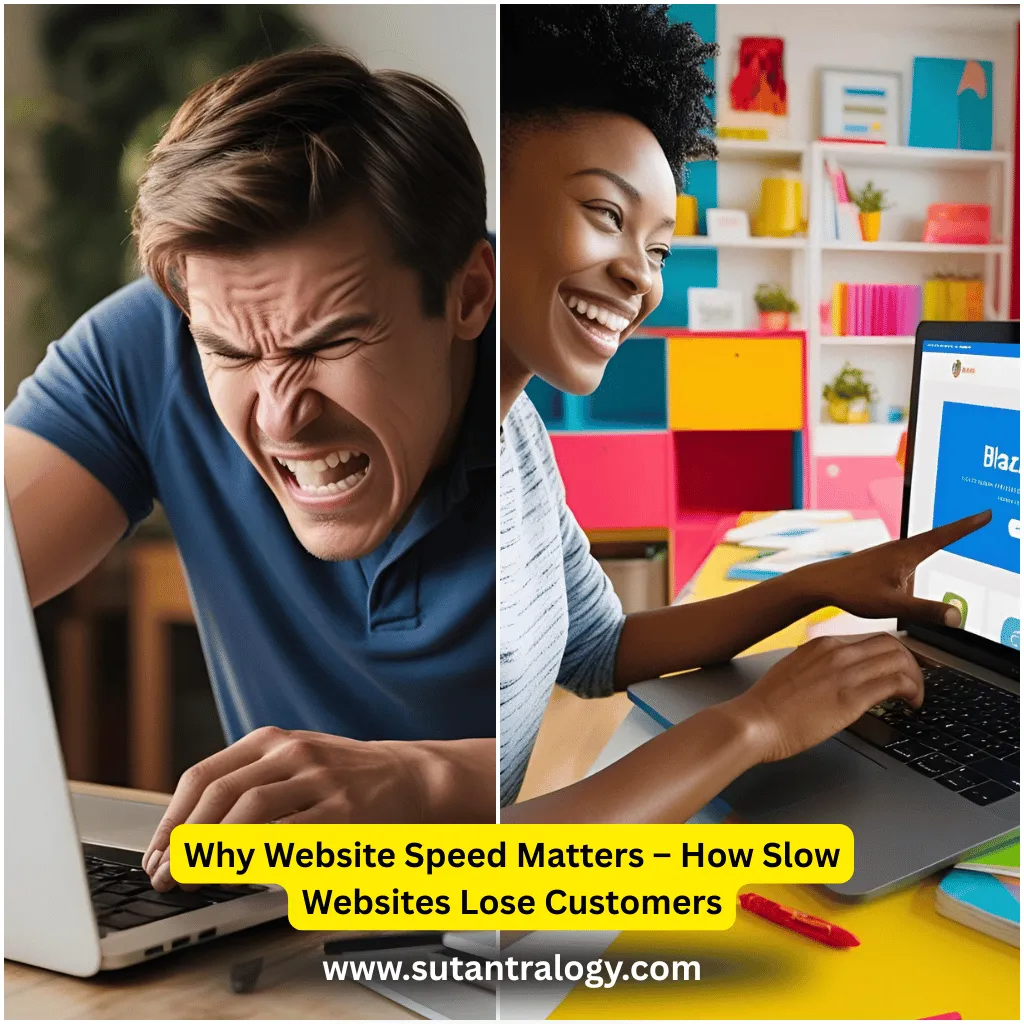
Let’s be honest—how long are you willing to wait for a website to load?
If your answer is more than 3 seconds, you’re a rare exception.
In the fast-paced digital world, speed is everything. Whether you’re running an e-commerce store, a personal blog, or a business website, your loading time directly impacts your traffic, conversions, and ultimately, your bottom line.
At Sutantralogy, we’ve worked with countless brands that didn’t realize how much revenue they were leaving on the table because of sluggish websites. If you think a few extra seconds won’t matter—this article might just change your mind.
First Impressions Happen in Milliseconds
Your website is often the first interaction a customer has with your brand. And guess what? People judge quickly. According to studies, users form an opinion about your website in less than 0.05 seconds.
A beautiful layout and excellent content mean nothing if your site takes ages to load.
Imagine walking into a store, and it takes three minutes before someone greets you or even turns the lights on. You’d probably walk out. Online, people are even less patient.
Numbers Don’t Lie: Speed Directly Impacts Conversions
Let’s look at some hard truths:
- 1 second delay in page response can result in a 7% reduction in conversions.
- 40% of users abandon a website that takes more than 3 seconds to load.
- Amazon found that every 100ms of latency cost them 1% in sales.
Now, you may not be Amazon, but these statistics prove a simple point:
💡 Speed = Conversions
Slow websites lose customers. Not because your product or service is bad, but because users never stick around long enough to find out.
How Slow Websites Hurt Your Business
1. 🧭 Higher Bounce Rates
Bounce rate is the percentage of visitors who land on your website and leave without interacting. A slow website causes frustration, which often leads to users bouncing off before even reading your content.
Google research shows that bounce rates increase by 32% as page load time goes from 1 to 3 seconds. By 5 seconds, it jumps to 90%.
2. 😠 Poor User Experience
People expect websites to be smooth, fast, and responsive. When they’re not, it damages your brand’s credibility. A bad experience on your website tells users that you’re either outdated, untrustworthy, or not serious about your business.
Would you buy from a store where the lights flicker, and the cash register lags? Exactly.
3. 🔍 Lower SEO Rankings
Google uses site speed as a ranking factor. If your website is slow, it might not even show up in the top results, no matter how great your content is.
Slow websites are also crawled less frequently by search engines, which affects how often your content gets indexed.
4. 📉 Reduced Revenue
It’s simple math:
Fewer people staying on your website = fewer leads, fewer purchases, less revenue.
If you’re investing in digital marketing, SEO, or paid ads but haven’t optimized your website speed, you’re wasting money. You’re bringing traffic to a store that keeps the door half-closed.
The Mobile Problem: It’s Worse Than You Think
Over 60% of internet traffic comes from mobile devices. And mobile users are even more impatient. On smaller screens, slower connections, and shorter attention spans—if your site lags, they bounce faster.
Google’s mobile-first indexing means your mobile site performance is now more important than your desktop version.
Bottom line? If your mobile website isn’t blazing fast, you’re invisible to a huge chunk of your audience.
What Causes a Website to Load Slowly?
Understanding what slows your site down is the first step to fixing it. Common culprits include:
- Unoptimized images: Large image files can slow load times dramatically.
- Too many plugins: Especially on platforms like WordPress.
- No browser caching: Every time someone visits your site, assets reload from scratch.
- Poor hosting: Cheap hosting may save money but costs performance.
- Excessive JavaScript or CSS files: Heavy scripts can delay rendering.
- Lack of Content Delivery Network (CDN): A CDN can distribute content more efficiently to users worldwide.
How to Speed Up Your Website
Now for the good news—most website speed issues are fixable.
Here’s a quick checklist we use at Sutantralogy when optimizing websites:
✅ Compress and resize images
✅ Minimize CSS, JavaScript, and HTML
✅ Enable browser caching
✅ Use a fast and reliable hosting provider
✅ Implement lazy loading for images and videos
✅ Reduce redirects
✅ Use a CDN like Cloudflare
✅ Run regular speed tests (Google PageSpeed Insights, GTmetrix, Pingdom)
You don’t have to do it all alone. At Sutantralogy, we help businesses optimize their website speed for both better UX and higher SEO rankings.
Real Talk: Speed Reflects Your Brand
Think of website speed as the digital handshake with your customer.
A fast, seamless experience shows professionalism, reliability, and attention to detail.
A slow experience? It tells your audience you’re not ready for prime time.
Even if you’re running a small local business, today’s customers expect big-brand performance. Speed isn’t a luxury anymore—it’s a baseline.
Conclusion:
It’s easy to overlook website speed. After all, if your site loads fine for you, it must be okay, right?
But your customers are using different devices, internet speeds, and expectations. A laggy experience for them could mean the difference between a new customer or a lost opportunity.
💡 Don’t let speed be the silent killer of your online business.
At Sutantralogy, we believe that every second counts—literally.
Whether you’re building a new site or fixing an old one, let us help you create a lightning-fast experience that keeps users coming back.
Want to see how your website performs?
Book a free website speed audit with Sutantralogy today.
Let’s make your first impression the best impression.

